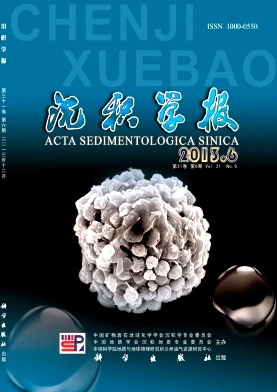Geochronological Comparison on Indosinian Tectonic Events Between Qinling Orogeny and Ordos Basin
- Publish Date: 2013-12-10
-
Key words:
- Indosinian movement /
- Ordos Basin /
- Qinling orogeny /
- mountain-basin coupling system /
- U-Pb dating of zircons /
- tuff /
- deep water sandstone /
Abstract: Qinling mountain and adjacent Ordos Basin constitute a mountain-basin coupling system. There is a close relation between Qinling uplifting and Ordos Basin forming. Indosinian, a key period of complicated Qingling orogeny, is characterized by the feature of polycyclic evolution. According to isotopic dating, Indosinian movement in Qingling area can be divided into three important stages, i.e., 230~238 Ma, 210~224 Ma and 198~206 Ma. Among them, the geological records in the middle stage are the most abundant. Geochronological correlation between orogenic belt and basin is difficult to be conducted, for it is difficult to study the age of sedimentary strata accurately. The deposition of tuff at the bottom of Ch7 oil bearing formation, an event layer, is characterized by wide spreading, isochronous and instantaneous. Abundant magmatic zircons are hosted in the tuff bed, and will act as a bridge on the isochronous correlation between Qingling orogenic belt and Ordos Basin. Based on U-Pb dating of zircons by the method of LA-ICP-MS collected from the tuff, the ages of tuff layers at the mid-upper and bottom of Ch7 oil bearing formation in Yanchang Formation are 221.8±2.0 Ma and 228.2±2.0 Ma, separately, respectively other depositional event ages are estimated further. It is put forward that the forming ages of uncomformities located at the bottom and top of Yanchang Formation are 237 Ma and 199.6 Ma, respectively, corresponding to the beginning or end of early and late stages of Indosinian tectonic events, and the age of the deepwater sandstone at mid-upper Ch7 and mid-lower Ch6 is formed during 215~224 Ma. Middle events, represented by tuff layer and mass gravity sand body, are identified in this study. The wide spreading tuff at the bottom of Ch7 oil-bearing formation and the thick deepwater sandstone, which is steadily distributed in depositional central of Ordos Basin, are the direct outcome of the middle event. Therefore, Indosinian movement resulted in two tectonic succession boundaries and two event deposits in Ordos Basin. In addition, eight coupling effects which were triggered by the middle event are uncovered in this paper. Some obvious transformations are revealed in sediment, petrology, geochemistry and biology. (1)The tuff layer at the bottom of Ch7 oil-bearing Formation is widely distributed in the west and southwest of Ordos Basin, covering more than 3×104 km2. (2)The landform altered from gentle slope and shallow-water to rapid and intense subsidence and wide spreading deep water. (3)Massive gravity sand body is distributed in the central of lacustrine, with some trace of tectonic event. (4)Asymmetry of basin become serious and the bottom shape is featured by western limb steep and the eastern limb gentle since Ch7 depositional period. (5)Compared with Ch10-Ch8 epoch, the basin central migrated counterclockwise since Ch7 epoch. (6)The sedimentary association developed from braided riverbraided river delta to alluvial fan-fan delta or alluvial fan-braided river-braided river-delta in the southwest and west of Ordos Basin. (7)Divided by the tuff layer at the bottom of Ch7 oil-bearing formation, there is a big gap in the content of quartz, feldspar, carbonate debris and chloritoid between Ch7-Ch1 sandstone and Ch10-Ch8 sandstone. (8)The sporopollen changed greatly. The sporopollen in Ch10-Ch8 strata is characterized by low diversity and fern spore stands dominant position. The sporopollen in Ch7-Ch1 mudstone is of high diversity and the content of gymnosperm pollen is banlance with fern spore. Therefore, comparison of Indosinian tectonic phases between Qinling orogenic zone and Ordos Basin shows a good agreement. However, process of mountain-basin coupling lasted long and is complicated, and further research is needed to be done.
| Citation: | Geochronological Comparison on Indosinian Tectonic Events Between Qinling Orogeny and Ordos Basin[J]. Acta Sedimentologica Sinica, 2013, 31(6): 939-953. |






 DownLoad:
DownLoad: